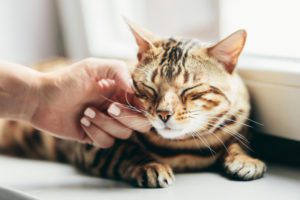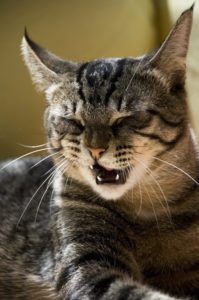Reverse Sneezing in Cats: Why is My Cat Doing it and is it Normal?
Reverse sneezing is a defense mechanism your cat utilizes when something triggers spasms in the diaphragm and abdominal muscles. The noise produced can be alarming, especially if you do not know what a reverse sneeze is.
The causes of reverse sneezing in cats are not that much different from regular sneezing. An allergen like dust or pollen may trigger your feline companion’s airways. Reverse sneezing is not as common in felines as in canines, but it is normal and is not serious most of the time.
Another common cause of reverse sneezing can be a foreign body trapped in the nasal cavity. If you believe your cat has been reverse sneezing but do not know why, check out this article.

What is Reverse Sneezing in Cats?
During a regular sneeze, air is forced out of the nasal cavity to remove any irritant that may be bothering your cat. The air is quickly pulled in through the nose with a reverse sneeze. The air travels up the nose to eliminate foreign substances. Reverse sneezing is unrecognizable to many cat parents, but it can sometimes look like something very serious is wrong.
The posture of a cat who is reverse sneezing usually entails them standing completely still, with their head and neck stretched outward, and they make unusual snorting or honking sounds. Many pet parents may mistake it for a seizure. The noises typically last for about a minute, and the sneezing will end after your cat expels air through their nose.
When your cat experiences irritation of the nasal cavity or throat, it can trigger the reverse sneeze. Instead of expelling air like in a regular sneeze, they rapidly inhale air. This “backward sneeze” happens because of a spasm within the throat, making the glottis narrow, and due to the unstable airflow, they make a loud snorting noise.
When the muscles contract and the laryngeal cartilage moves, it creates pressure which opens the glottis. The immediate opening of the glottis causes a powerful inward airflow that decreases irritants and mucus. Airflow into the nasopharynx results in the elimination of mucus through the digestive tract or by coughing.
It may sound complicated, but reverse sneezing is generally not harmful, and the cat usually recovers quickly from the episode.
What Triggers Reverse Sneezing in Cats? 
Your cat could be sneezing for a lot of reasons. The causes of reverse sneezing in cats are similar to the causes of regular sneezing. Reverse sneezing is more frequent in dogs than cats. However, there are occasions when felines reverse sneeze. The following include potential explanations why a cat may be reverse sneezing:
- Allergens like dust, pollen, mold, perfume, cigarette smoke, and candles are some irritants that could cause sneezing. If sneezing is related to allergies, their skin may also be itchy.
- Drainage of discharge could be triggered by a runny nose resulting from nasal or upper respiratory infections. An infected cat may have thick discharge running from their eyes as well.
- Feline upper respiratory infections can precipitate sneezing in your cat, and your cat may have yellow, green, or bloody discharge coming out of their eyes or nose. It may be viral, bacterial, or fungal.
- Tumors or growths of the voice box or trachea are rare in cats. They can cause problems with inhaling and exhaling. Coughing, wheezing, or exercise intolerance may also occur.
- Brachycephalic airway syndrome occurs when there are upper airway abnormalities like an extended soft palate. The soft palate is too lengthy for the mouth, and the trachea’s entrance is partially blocked.
- Lower respiratory tract infections may cause coughing and difficulty breathing, and these infections can be initiated by bacteria, fungi, parasites, or viruses. Feline asthma can trigger the illness.
- The feline herpes virus can trigger upper respiratory symptoms, ulcers on the cornea, and fever. The virus causes lifelong infection in most cats affected.
- Overexcitement can sometimes trigger sneezing. Like humans, it can be expected for cats to sneeze several times in a row due to emotional stimuli.
- Nasal polyp symptoms often look like an upper respiratory infection. Sneezing, respiratory sounds, and nasal congestion may all be present.
- Foreign bodies, such as blades of grass, can enter the nasal cavity. There will be irritation first, and an infection may occur if the foreign body is not expelled.
- Dental disease can cause sneezing, mostly involving root infections. Infections in a cat’s tooth can result in bacteria in the sinuses, leading to inflammation and sneezing.
- Intranasal vaccines that protect against respiratory infections can trigger sneezing for a few days after they are dispensed. The sneezing typically goes away on its own without treatment.
A sudden temperature change can also trigger reverse sneezing. Sneezing due to eating or drinking too quickly falls in line with sneezing due to excitement.
Sometimes your cat may get excited about their food or water, causing them to ingest them too quickly, which can cause them to sneeze. Exercise intolerance in cats may also result in sneezing, as some cats do not enjoy strenuous activity, which can lead to excess weight.
My Cat is Reverse Sneezing. What Can I Do?

Although reverse sneezing is typically nothing to worry about, it can be discomforting for both you and your cat if it persists for too long. If your cat is experiencing this, there are some ways that you can help shorten the duration of their reverse sneezing.
You can gently massage your cat’s throat, which may soothe them and ease discomfort. If this does not work out, you can make an attempt to blow short puffs of air into your feline’s face. The blowing can sometimes put a stop to the repetition of the reverse sneezing. If your cat does not respond favorably to these little tricks, speak softly and sweetly to reassure them and make them feel secure and comfortable.
You should also try to maintain your house by cleaning and keeping it free of irritants triggering reverse sneezing. If your cat is prone to colds or respiratory infections, you can get a humidifier to help keep their nasal passages clear, and they may breathe easier. Any comfort and cuddles you can offer your feline companion will also help them.
If your cat’s reverse sneezing is constant, and you have tried helping them to no avail, you can record a video of your cat reverse sneezing and show your veterinarian. The video will help your vet see what your cat is experiencing, and even if there is no medical issue, they may have more practical tips to help.
Conclusion
If you do not know about the reverse sneeze, it can be alarming to see your cat in an odd posture and making lots of awkward noises. However, reverse sneezing is generally nothing to worry about, and there are ways you can help your feline companion feel more comfortable.
If you have further questions about reverse sneezing in your cat, or if you are looking for a veterinarian in Lake City, FL, Lake City Animal Hospital is here to help. Give us a call at (386) 755-0236 or book an appointment online!


